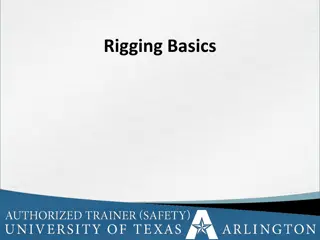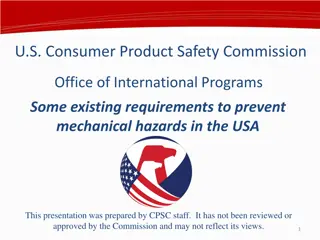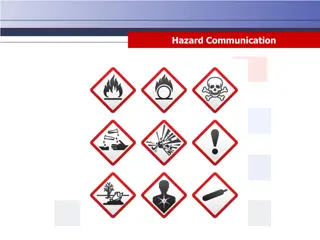Oil and Gas Industry Hazards and Control Measures
Learn to mitigate fire, explosion, exposure, physical hazards, falls, transportation risks, and natural hazards in the oil and gas sector. Effective control measures reduce risks and ensure worker safety. Explore key safety protocols.
2 views • 13 slides
Enhancing Workplace Safety Through Safety Kaizen Methodology
Safety Kaizen is a continuous improvement approach focused on identifying and addressing safety hazards to create a safer work environment. It involves steps such as problem identification, root cause analysis, brainstorming solutions, implementing improvements, monitoring progress, and involving em
1 views • 5 slides
Comprehensive Workplace Health and Safety Training Program for Professionals
Explore a wide range of self-paced modules covering topics such as mental health, workers' compensation, risk management of psychosocial hazards, bullying and harassment, injury prevention, and more. Enhance your knowledge and skills to create a safe and healthy workplace environment for employees.
2 views • 6 slides
Ensuring Mine Road Safety: Key Controls and Hazards
National Mine Safety Week 2023 focuses on safe road conditions in mining areas. The environment poses risks like overhanging trees and weather conditions, while road-related hazards include heavy loads and road design issues. This article highlights driving hazards, road design and maintenance hazar
1 views • 9 slides
Workplace Hazards and Safety Measures Awareness
Learn about common workplace hazards such as falls, chemical exposure, fire, electrical hazards, and repetitive motion injuries. Understand the risks associated with these hazards and the importance of prioritizing safety in the workplace to prevent accidents and injuries. Stay informed and take pro
1 views • 33 slides
Workplace Adjustments and Employee Lifecycle Overview
This content discusses the key stages in the employee lifecycle where workplace adjustments may be necessary to support employees effectively. It emphasizes the importance of providing reasonable adjustments as required under the Equality Act 2010, especially during recruitment, induction, performan
3 views • 4 slides
Biological Hazards in the Hospital Community
Healthcare workers face various occupational hazards, including biological risks, in hospital settings. This article by Ephraim E. Ibadin explores the definition, types, risk factors, sources, prevention, and control of biological hazards in hospitals, emphasizing the importance of protecting worker
0 views • 30 slides
Environmental Hazards Faced by Veterans and Agent Orange Exposure Locations
Veterans may have been exposed to a variety of environmental hazards during their military service, including Agent Orange-related diseases, Gulf War illnesses, radiation-related diseases, traumatic brain injury, and more. Agent Orange exposure locations include Vietnam, C-123 airplanes, Blue Water
1 views • 40 slides
Essential Crane Safety Training and Hazards Awareness
This training covers various hazards associated with crane use, OSHA standards, inspection guidelines, and common issues like electrical hazards, overloading, and poor weight distribution. The content emphasizes the importance of maintaining crane safety to prevent accidents, injuries, and damage to
0 views • 30 slides
Rigging Safety and Hazards Awareness
Learn about common rigging hazards, including fall hazards, struck-by and crushing hazards, electrical hazards, and rigging failure examples. Understand the importance of proper training, equipment inspection, and safety protocols to prevent accidents and injuries in rigging operations.
0 views • 34 slides
Importance of Job Hazard Analysis (JHA) in Workplace Safety
Job Hazard Analysis (JHA) is a crucial technique that focuses on identifying and mitigating hazards in work environments to prevent injuries, illnesses, and property damage. This analysis involves breaking down job tasks, identifying potential hazards, implementing controls, and providing necessary
0 views • 13 slides
Preventing Mechanical Hazards in Consumer Products: U.S. Regulations
The U.S. Consumer Product Safety Commission (CPSC) enforces various requirements to prevent mechanical hazards in consumer products. These regulations cover toys, children's clothing, infant products, and more. Standards such as ASTM F963 outline specific safety measures for small parts, strangulati
1 views • 13 slides
Workplace Health and Safety Training and Procedures
Maintaining a safe work environment is crucial. This comprehensive guide covers various aspects of health and safety in the workplace, from specific training programs to reporting procedures for incidents and hazards. Learn about using concern forms, submitting employee incident reports, accessing b
2 views • 19 slides
Importance of Workplace Inspections and Hazard Identification
Workplace inspections are critical processes to identify and mitigate hazards in a work environment. These inspections help ensure the safety of employees by addressing potential risks such as biological, chemical, physical, safety, ergonomic, and psychosocial hazards. Regular inspections allow for
2 views • 12 slides
Understanding Natural Hazards and Their Impacts
Natural hazards, including tectonic and weather-related events, pose significant risks to humans and property. The effects and responses to tectonic hazards vary based on wealth levels in different regions. Earthquakes and volcanic eruptions result from physical processes, with patterns observed alo
1 views • 15 slides
Understanding Natural Hazards and Their Impact on Society
Explore the world of natural hazards, their causes, examples, and the transition to natural disasters. Learn how human actions can influence the frequency and severity of hazards. Discover the interconnectedness between nature and society in dealing with these events.
0 views • 10 slides
Understanding Risk Assessments and Hazards in Everyday Life
Risk assessments involve evaluating potential hazards and assessing the likelihood and consequences of those hazards. In the context of crossing the road, different scenarios demonstrate varying levels of risk based on factors such as vehicle speed, pedestrian behavior, and road conditions. By under
0 views • 23 slides
Importance of Head Protection in Workplace Safety Training
Head protection, particularly hard hats, is crucial in preventing life-threatening head injuries in the workplace caused by falling or flying objects, bumps, and other hazards. This training covers identifying head hazards, types of hard hats, limitations, proper use, and care. Hard hats offer a rig
0 views • 21 slides
Ensuring Office Safety: Hazards, Prevention, and Training
Today's offices are prone to various hazards that can lead to injuries and health issues. This presentation covers common office accidents, safety considerations, and preventive measures such as ergonomic practices, fall prevention, and emergency action plans. It emphasizes the importance of control
0 views • 44 slides
Occupational Hazards in Healthcare and Engineering Equipment Development for COVID-19 Protection
Corona Virus, or COVID-19, poses significant health hazards to individuals, especially healthcare workers. This article explores the spread of the virus, types of health hazards, and solutions for prevention. It emphasizes the critical need for developing engineering equipment to support and protect
0 views • 12 slides
Understanding Environmental Hazards and Management
Exploring major hazards management, geology perspectives, ecological concepts, natural environmental hazards, classes of natural hazards, and introduction to environmental hazards management. The content covers ecological levels, abiotic factors, biomes, environmental degradation, and more.
0 views • 10 slides
Understanding Workplace Safety Hazards: Physical, Chemical, and Biological Risks
Explore the three main types of workplace safety hazards - physical, chemical, and biological - with a focus on identifying potential risks and ensuring a safe work environment. Learn about common hazards such as repetitive motion, chemical exposure, and handling biological materials, essential for
0 views • 97 slides
Importance of Personal Protective Equipment in Workplace Safety
Personal Protective Equipment (PPE) plays a crucial role in safeguarding workers from workplace hazards like physical, electrical, mechanical, and chemical risks. PPE includes safety shoes, helmets, goggles, masks, overalls, harnesses, gloves, earplugs, vests, ear muffs, and face shields. Employers
0 views • 6 slides
Importance of Health and Safety in the Workplace
Health and safety are crucial for all employees, as outlined in the Ontario Health and Safety Act. Employers and employees share the responsibility of creating a safe work environment through enforcement, compliance, and partnership. Understanding hazards, both safety and health-related, is key in p
0 views • 24 slides
Understanding Natural Hazards and Plate Boundaries
Learn about natural hazards such as volcanic eruptions, earthquakes, and storms that pose risks to human populations. Discover how factors like urbanization, poverty, climate change, and farming increase vulnerabilities to these hazards. Explore plate boundaries, crust types, and examples of geologi
0 views • 21 slides
Fire Safety Course: Protect Yourself and Your Workplace
Learn how to prevent fires and injuries at work by taking a fire safety and prevention course. Discover how to assess and mitigate fire hazards to ensure a safe work environment. The course covers essential elements of a fire prevention plan and provides valuable insights into workplace safety. Join
0 views • 6 slides
Workplace Safety Strategies from Mines Safety Roadshow
This presentation, derived from the Mines Safety Roadshow in 2014, emphasizes the importance of risk management, hazard identification, and safety controls in mining operations. Key takeaways include understanding major hazards, thorough JHA/JSA comprehension, and supervisors' obligations under safe
0 views • 19 slides
Preventing Slips, Trips, and Falls: Hazard Awareness and Safety Guidelines
Be aware of hazards both indoors and outdoors to prevent slips, trips, and falls. Keep work areas clear, return equipment to designated places, and report hazards to managers promptly. Look ahead for hazards, avoid distractions while walking, and conduct dynamic risk assessments to ensure safety. Re
0 views • 4 slides
Understanding Environmental Health and Hazards
The field of environmental health focuses on preventing human injury and illness by evaluating and limiting exposure to hazardous agents in the air, water, and soil. Various environmental hazards such as water and air pollution, climate change, and occupational hazards pose significant risks to huma
0 views • 10 slides
Understanding Processor Hazards and Pipeline Stalls
Explore processor hazards like load-use and data hazards, along with strategies to avoid stalls in the pipeline. Discover how to detect and handle hazards efficiently for optimal performance in computer architecture. Learn about forwarding conditions, datapath design, and the impact of hazards on in
0 views • 30 slides
Combining Natural Hazards with Societal Issues: Unit 1 Hazard Map Template
Delve into Unit 1 of the Hazard Map Template, identifying and locating regions susceptible to hazards by choosing top hazards in the mapping area. Create hazard maps, combine shapes, and include a key and sources for a comprehensive view of potential hazards and vulnerabilities.
0 views • 13 slides
Importance of Hazard Communication Training for Workplace Safety
Hazard communication training is essential for creating a safe work environment by helping individuals recognize and manage hazardous materials effectively. Understanding the Globally Harmonized System (GHS) and following hazard communication laws can improve workplace safety, protect human health,
0 views • 36 slides
Understanding Pipeline Hazards in Computer Architecture
Pipeline hazards in computer architecture are classified into three categories: structural, data, and control hazards. Structural hazards occur due to conflicts in hardware resources, data hazards stem from dependencies between instructions, and control hazards arise from branching instructions. The
0 views • 42 slides
Workshop on Artificial Intelligence in Natural Hazards Engineering
This workshop focuses on exploring the integration of artificial intelligence and machine learning with natural hazards engineering, discussing data representations, classification models, combining ML with hazards simulations, and addressing classification problems in the field. Participants engage
0 views • 5 slides
Map Your Hazards Module Overview: Identifying Natural Hazards and Social Vulnerabilities
Explore the Map Your Hazards Module, a comprehensive program designed to help communities identify natural hazards, assess social vulnerabilities, and enhance preparedness. Through tasks like local risk mapping and social surveys, learn to mitigate risks and support communities in facing potential d
0 views • 17 slides
Recognizing Laboratory Hazards: Physical Hazards and Corrosive Chemicals
Laboratory hazards, particularly physical hazards and corrosive chemicals, pose risks to individuals working in laboratory settings. Corrosives, such as acids, bases, oxidizing agents, and gases, can cause significant harm to eyes and skin. Proper precautions and handling procedures are crucial to m
0 views • 16 slides
Workplace Violence Prevention Training & Discrimination in the Workplace
Workplace violence prevention training is crucial to ensure safety in the workplace. This training covers the definition of workplace violence, types of violence, actions that must be reported, and worst-case scenarios. It emphasizes avoiding disruptive behaviors like verbal abuse and outlines incid
0 views • 23 slides
Data Hazards in Pipelined Processors: Understanding and Mitigation
Explore the concept of data hazards in pipelined processors, focusing on read-after-write (RAW) hazards and their impact on pipeline performance. Learn strategies to mitigate data hazards, such as using a scoreboard to track instructions and stall the Fetch stage when necessary. Discover how adjusti
0 views • 23 slides
Understanding Biological Hazards in the Workplace: A Comprehensive Overview
This chapter delves into the realm of biological hazards in occupational settings, shedding light on the risks posed by microorganisms, arthropods, allergens, toxins, and more. It highlights the diverse range of biological agents that can lead to infections, allergies, toxic reactions, and even seri
0 views • 45 slides
Workplace Safety Guidelines and Objectives
This content provides comprehensive information on workplace safety, including general safety rules, evacuation routes, use of safety equipment, personal protective equipment, hazardous materials safety, and first aid principles. It emphasizes the importance of maintaining a safe work environment, i
0 views • 54 slides







































